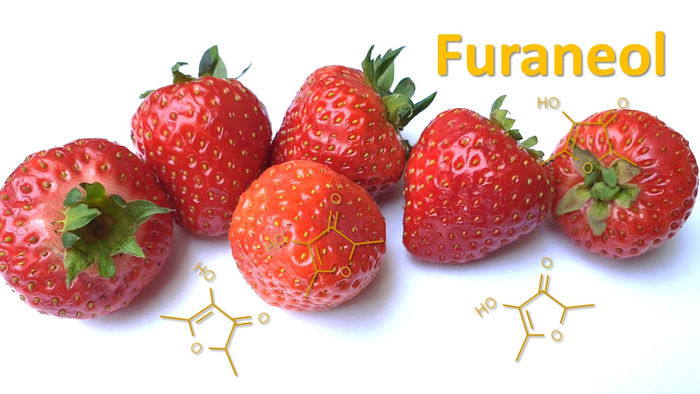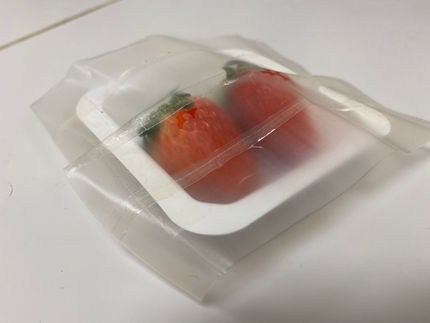"Caramel receptor" identified
Who doesn't like the smell of caramel? However, the olfactory receptor that contributes decisively to this sensory impression was unknown until now. Researchers at the Leibniz Institute for Food systems biology at the Technical University of Munich (LSB) have now solved the mystery of its existence and identified the "caramel receptor". The new knowledge contributes to a better understanding of the molecular coding of food flavors.

The odorant furaneol gives strawberries and other foods a caramel-like aroma. Figure: G. Olias / LSB, The figure shows strawberries an the structural formula of the odorant furaneol.
G. Olias / LSB
Furaneol is a natural odorant that gives numerous fruits such as strawberries, but also coffee or bread, a caramel-like scent. Likewise, the substance has long played an important role as a flavoring agent in food production. Nevertheless, until now it was unknown which of the approximately 400 different types of olfactory receptors humans use to perceive this odorant.
Odorant receptors put to the test
This is not an isolated case. Despite intensive research, it is still only known for about 20 percent of human olfactory receptors which odorant spectrum they recognize. To help elucidate the recognition spectra, the team led by Dietmar Krautwurst at LSB is using a collection of all human olfactory receptor genes and their most common genetic variants to decipher their function using a test cell system.
"The test system we developed is unique in the world. We have genetically modified the test cells so that they act like small biosensors for odorants. In doing so, we specify exactly which type of odorant receptor they present on their cell surface. In this way, we can specifically investigate which receptor reacts how strongly to which odorant," explains Dietmar Krautwurst. In the present study, the researchers examined a total of 391 human odorant receptor types and 225 of their most common variants.
Only two odorants for one receptor
"As our results show, furaneol activated only the OR5M3 odorant receptor. Even one thousandth of a gram of the odorant per liter is sufficient to generate a signal," says first author of the study Franziska Haag. In addition, the team investigated whether the receptor also reacts to other odorants. To this end, the team examined 186 other substances that are key odorants and therefore play a major role in shaping the aroma of food. Of these, however, only homofuraneol was able to significantly activate the receptor.
This odorant is structurally closely related to furaneol. As shown by previous LSB studies, it imparts a caramel-like aroma to fruits such as durian. "We hypothesize that the receptor we identified, OR5M3, has a very specific recognition spectrum for food ingredients that smell caramel-like. In the future, this knowledge could be used to develop new biotechnologies that can be used to quickly and easily check the sensory quality of foods along the entire value chain," says Dietmar Krautwurst. Although there is still a long way to go to understand the complex interplay between the approximately 230 key food-related odorants and human olfactory receptors, a start has been made, the molecular biologist adds.
Veronika Somoza, Director of the Leibniz Institute adds: "In the future, we will continue to use our extensive odorant and receptor collections at the Institute to help elucidate the molecular basis of human olfactory perception. After all, this significantly influences our food choices and thus our health."
Original publication
Most read news
Original publication
Topics
Organizations
Other news from the department science

Get the food & beverage industry in your inbox
By submitting this form you agree that LUMITOS AG will send you the newsletter(s) selected above by email. Your data will not be passed on to third parties. Your data will be stored and processed in accordance with our data protection regulations. LUMITOS may contact you by email for the purpose of advertising or market and opinion surveys. You can revoke your consent at any time without giving reasons to LUMITOS AG, Ernst-Augustin-Str. 2, 12489 Berlin, Germany or by e-mail at revoke@lumitos.com with effect for the future. In addition, each email contains a link to unsubscribe from the corresponding newsletter.





























































